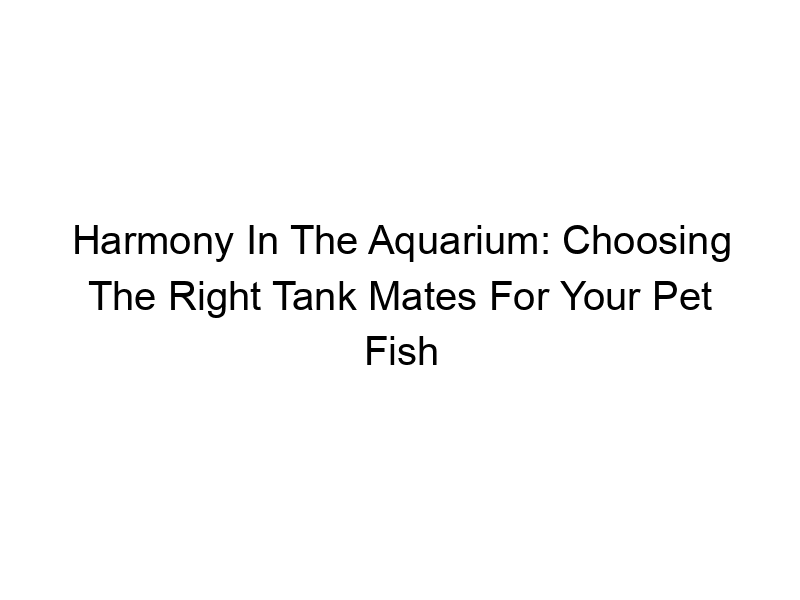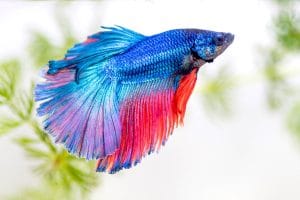Introducing a new fish to your established aquarium can be an exciting experience, but it’s crucial to understand the importance of choosing the right tank mates for your pet fish. This comprehensive guide will walk you through the process, covering everything from understanding fish compatibility to creating a thriving and peaceful underwater community. We’ll explore factors like temperament, size, habitat requirements, and potential diseases, equipping you with the knowledge to make informed decisions and avoid common pitfalls. You’ll learn how to identify compatible species, assess your tank’s capacity, and maintain a healthy aquarium environment for all your finned friends.
Choosing compatible tank mates hinges on understanding their temperaments. Some fish are inherently peaceful and thrive in community tanks, while others are aggressive and territorial.
Researching each species’ typical behavior is paramount. For instance, peaceful community fish like tetras and rasboras are excellent choices for beginners, while more aggressive cichlids require specific tank setups and careful companion selection.
Size and Growth Rate: Avoiding Overcrowding
Consider the adult size of each fish. A small fish might be an appropriate tank mate for a larger fish initially, but this can change dramatically as the smaller fish grows. Overcrowding leads to stress, aggression, and disease outbreaks. Plan for the future size of all inhabitants and ensure your tank provides ample space for all to thrive without feeling cramped. Regular water changes are also crucial for managing waste buildup in a well-populated tank.
Habitat Requirements: Mimicking Natural Environments
Different fish species have diverse environmental preferences. Factors such as water temperature, pH levels, water hardness, and the presence of plants or hiding places all play a crucial role in their well-being. Matching these requirements is essential for creating a comfortable and healthy environment for all your fish. For example, certain fish prefer cooler water, while others require warmer temperatures; ignoring this can lead to stress and illness.
Species-Specific Compatibility: A Detailed Look at Popular Choices
Popular Community Fish: Tetras, Rasboras, and More
Tetras and rasboras are popular choices for beginners due to their peaceful nature and vibrant colors. However, even within these groups, there are variations in temperament. Some species are more active than others, and some may be prone to nipping fins. Researching the specific needs of each species you consider is essential. For example, cardinal tetras are generally peaceful, while black skirt tetras can be more boisterous.
Semi-Aggressive Fish: Balancing Peace and Personality
Some fish exhibit semi-aggressive behaviors, such as occasional fin nipping or territorial disputes. These fish can be integrated into a community tank, but careful planning is crucial. Consider species like certain gouramis or dwarf cichlids, which can add personality without creating constant conflict. Understanding their triggers and providing ample hiding places and open swimming space can help mitigate aggressive behavior.
Aggressive Fish: Specialized Tanks and Careful Selection
Aggressive fish, such as some larger cichlids, require specialized tanks and careful consideration of tank mates. They often require large tanks with many hiding places and territorial dividers. Keeping only one male of a particularly aggressive species is often necessary, or establishing a strong hierarchical structure with multiple females to avoid constant fighting.
Assessing Your Tank’s Capacity: Avoiding Overstocking
The One-Inch-Per-Gallon Rule: A Basic Guideline
The one-inch-per-gallon rule is a widely used guideline for determining your tank’s capacity. This rule dictates that for every inch of adult fish length, you should have one gallon of water. However, this is a very basic guideline, and many factors such as the fish’s activity level, waste production, and the type of filtration can impact this. It’s often better to err on the side of caution and provide more space than this rule suggests.
Bioload: The Impact of Fish Waste
The bioload, or the amount of waste produced by the fish, is crucial for maintaining water quality. Overstocking leads to a high bioload, overwhelming the filtration system and causing a rapid deterioration of water parameters, resulting in ammonia spikes and endangering the lives of your fish. Regular partial water changes are essential to help control the bioload and maintain healthy water parameters.
Filtration and Aeration: Supporting a Healthy Environment
Adequate filtration and aeration are crucial for supporting a healthy aquatic environment, especially in tanks with multiple fish. A high-quality filter effectively removes waste and keeps the water clean, while proper aeration provides sufficient oxygen for all the inhabitants. Overstocked tanks will severely stress a filtration system, even a powerful one, causing reduced water quality and fish stress.
Introducing New Fish: A Gradual and Careful Process
Acclimating New Fish: Reducing Stress
Acclimating new fish to their new environment is vital to reduce stress and the risk of disease. Slowly introduce them to the tank water over a period of 30-60 minutes using a floating bag or drip acclimation method. This gradual adjustment allows them to adapt to the water parameters and minimizes shock.
Quarantine: Preventing the Spread of Disease
Quarantining new fish for a period of 2-4 weeks before introducing them to the main tank is crucial to prevent the introduction of diseases and parasites. A separate quarantine tank allows you to monitor the new fish for any signs of illness without risking the health of your established community. This preventative measure can save your entire aquarium.
Observing Fish Behavior: Early Detection of Problems
Careful observation of your fish’s behavior after introducing new tank mates is essential. Look for any signs of stress, such as fin clamping, loss of appetite, or unusual swimming patterns. Early detection of problems allows for prompt intervention and can prevent the escalation of issues.
Maintaining Water Quality: A Crucial Aspect of Tank Mate Success
Regular Water Changes: Removing Waste and Maintaining Stability
Regular partial water changes are essential for maintaining water quality. This process removes accumulated waste products, maintains stable water parameters, and prevents the build-up of harmful substances. Aim for weekly or bi-weekly partial water changes of around 25-50% of the tank’s water volume.
Water Testing: Monitoring Key Parameters
Regular water testing is crucial for monitoring key water parameters such as ammonia, nitrite, and nitrate levels. These tests provide valuable insights into the overall health of your aquarium and allow you to address any imbalances promptly. Using a reliable test kit and understanding the ideal range for each parameter is essential for maintaining a thriving environment.
Tank Cleaning: Maintaining a Clean and Healthy Habitat
Regular tank cleaning, including removing uneaten food, waste buildup, and algae, contributes to maintaining a healthy environment for all your fish. Regularly cleaning the substrate and filter media (following manufacturer’s instructions) ensures optimal water quality.
Choosing the Right Tank Size: A Critical Consideration
Matching Fish Size to Tank Volume: Avoiding Overcrowding
The size of your tank directly impacts the number and type of fish you can keep. Overcrowding leads to stress, aggression, and disease outbreaks. Carefully research the adult size of each fish species and ensure your tank provides adequate space for all.
Considering Tank Shape and Design: Impact on Space and Behavior
Tank shape and design can also influence space and fish behavior. Tall tanks are often better suited for active swimmers, while wider tanks provide more floor space for bottom-dwelling fish. Consider the natural behavior of your chosen species when selecting a tank.
Advanced Considerations for Experienced Aquarists
Incorporating Live Plants: Providing Cover and Natural Aesthetics
Live plants offer many benefits, providing cover for shy fish, enhancing water quality, and adding natural aesthetics to your aquarium. However, introducing plants requires careful planning to ensure they are compatible with your chosen fish. Some fish will actively eat or uproot plants.
Creating Biotopes: Mimicking Specific Habitats
For experienced aquarists, creating biotopes – miniature recreations of specific natural habitats – offers a rewarding challenge. This requires detailed research and careful selection of compatible species and plants to accurately mimic the desired ecosystem.
Breeding Fish: Understanding Breeding Requirements and Compatibility
Breeding fish requires extensive knowledge and planning. Understanding the specific breeding requirements of your chosen species, including compatibility, tank size, and water parameters, is essential for successful reproduction.
Frequently Asked Questions
What are the most common mistakes when choosing tank mates?
Common mistakes include ignoring temperament differences, underestimating adult fish size, neglecting habitat requirements, and failing to acclimate new fish properly. Overstocking is also a significant error, leading to high bioload and poor water quality.
How do I know if my fish are stressed?
Signs of stress include fin clamping, lethargy, loss of appetite, rapid breathing, and unusual swimming patterns. Sudden changes in water parameters or the introduction of incompatible tank mates are common stressors.
What is the best way to acclimate new fish?
Acclimation involves gradually adjusting the new fish to the tank water’s temperature and chemical parameters over 30-60 minutes using a drip acclimation method or a floating bag. This prevents shock and reduces stress.
How often should I perform water changes?
Aim for partial water changes of around 25-50% of the tank’s volume weekly or bi-weekly, depending on the bioload. Regular changes help maintain water quality and prevent the buildup of harmful substances.
How can I prevent disease outbreaks?
Preventative measures include quarantining new fish, maintaining good water quality, providing a suitable diet, and avoiding overstocking. Regular observation of your fish’s behavior is also crucial for early detection of any potential problems.
Final Thoughts
Successfully choosing the right tank mates for your pet fish requires careful planning and understanding of fish behavior, habitat requirements, and water quality. This guide has outlined crucial aspects for creating a harmonious and thriving underwater community. Remember, research is your best friend. Before introducing any new fish, thoroughly investigate their specific needs and potential compatibility with your existing inhabitants. By diligently following these guidelines and engaging in consistent monitoring and maintenance, you can create a beautiful and healthy aquarium environment for years to come. Start planning your harmonious underwater world today!




